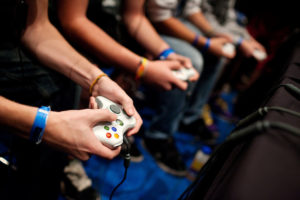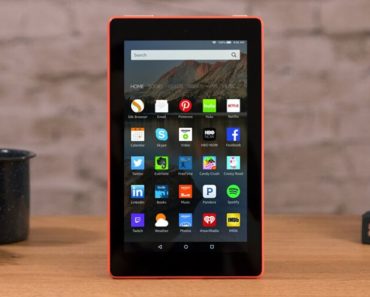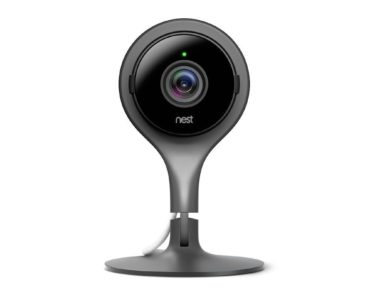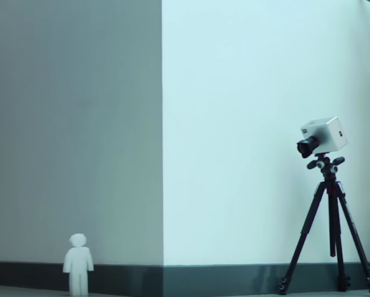Roberto Garcia, known online as Towelliee, is a star broadcaster on Twitch, a streaming platform whose popularity has turned recreational gaming into an improbably viable career. Each month, a hundred million visitors watch their favorite personalities play video games on Twitch, spending an average of nearly two hours a day there. This audience is large enough to make the site one of the twenty most trafficked in the U.S., yet it’s perhaps more apt to measure Twitch against a different medium. With viewership numbers that rival those of MSNBC or CNN, Twitch is less like a conventional Web site than like a kaleidoscopic television network: thousands of channels at once, broadcasting live at every hour of the day.
Shortly before noon, Dariani pulled up in front of the Viejas Casino & Resort and handed his keys to a valet. He strode inside, eyes scanning the acres of slot machines. Though Dariani is chummy and non-judgmental with clients, he’s seen enough drunk streamers fall off balconies at industry parties to inspire an almost parental anxiety. He glanced at his phone, and then showed me an eclectically punctuated text from Garcia. “That’s probably not a good sign of sobriety,” he said. Yet when Garcia appeared—bearded, stout, and wearing aviator sunglasses—he was convivial but composed. “I just watched my girlfriend lose nine hundred dollars in about three minutes,” he announced cheerfully.
Garcia led us up to the casino’s Presidential Suite, where his girlfriend, Aracely, was waiting at the bar. When Garcia started streaming, in 2010, he’d recently been laid off from a quality-assurance job at a pharmaceutical-software company; he and Aracely scraped by on unemployment checks and her wages from Costco. Game broadcasting was new, and the business model all but nonexistent. Still, Garcia thought that he could make it work, so he sat Aracely down to convince her. “Imagine telling your girlfriend, ‘I’m going to stop looking for a job and play video games for a living,’ ” he told me. Aracely, sitting beside him, nodded. “It was a hard conversation,” she said.
Game streaming, Garcia discovered, required non-stop work. The only way to attract viewers, and to prevent the ones you had from straying to other broadcasters, was to be online constantly, so he routinely streamed for eighteen hours a day. “That’s what I had to do to grow the viewership,” he said. His ankles swelled from sitting at his computer. His weight grew to four hundred and twenty pounds.
Garcia’s specialty is the multiplayer fantasy game World of Warcraft. While he isn’t its best player, he has a knack for talking entertainingly over his play: he is funny, brash, and filled with stories about his delinquent childhood in Newark. (“I was so bad, I got kicked out of the dare program,” he told me.) After a year of broadcasting, he had a steady audience of seven hundred, but he was still desperately broke. During a stream, he asked viewers to help him hang on a little longer. One sent him fifteen hundred dollars—a gift that reduced Garcia to tears. “I had to shut my mike off and walk away,” he said. “Everyone was, like, ‘Where’d he go? Is he dead from the donation?’ ”
Six years later, Garcia makes several times that amount on a good day. Since 2011, he has been one of Twitch’s “partners,” an élite group that includes some twenty-five thousand streamers, of the 2.2 million active on the site. Between his thousands of subscribers—who pay a monthly fee for access to perks such as ad-free viewing—and his sponsorships, appearance fees, and tips, he earns a “low- to mid-six-figure” income. His streaming schedule has become more manageable, though it remains arduous: sixty hours a week, no days off except occasional Saturdays. He has devoted nearly thirty thousand hours to World of Warcraft. “I’m a grinder, man,” he told me.
To sponsors, Twitch offers a novel opportunity: access to a generation that resists traditional advertising media but is steeped in video games. Young people watch game streaming in huge numbers (Twitch claims to reach half of the millennial males in the United States) and often in prodigious quantities. “This year, Towelliee’s viewers have watched five hundred and ninety-four years of his content,” Dariani said. In 2016, Garcia sold nearly three million dollars’ worth of his sponsors’ products through links on his Twitch channel.
For all the traffic and revenue that Twitch generates, the game-streamingmarket remains a free-for-all, its driven, rambunctious broadcasters struggling to manage their newfound success. Omeed Dariani, the CEO of Online Performers Group – a talent management firm that represents professional video game players, aims to become streaming’s William Morris—a pioneering talent manager who leads a new class of entertainer into professionalism. Already, his best-paid clients can earn two million dollars a year; some command twenty thousand dollars to play a studio’s game for a single three-hour stream. Executives both covet and fear Twitch broadcasters’ influence. “This eighteen-year-old punk kid shows up,” Dariani told me, describing a typical meeting with potential sponsors, “and he’s talking about how things are ‘retarded’ and making fart jokes and not listening to your team with a hundred years of experience. And you’re sitting there going, ‘This is the guy who makes the decision about whether my company succeeds or fails?’ ” Dariani smiled. “First you’re angry. But then you’re terrified.”
Online Performers Group’s office sits on the top floor of a putty-gray building in San Diego’s Point Loma neighborhood, less than a mile from the airport; the roar of plane traffic frequently interrupts conversation. “We call it the Point Loma pause,” Dariani said. “It gives you time to reflect.” One recent afternoon, Oliver Pascual, an account manager, stood at his desk watching a client’s stream of a game called Farming Simulator 17. Onscreen, a grimy blue tractor hauled a trailer through an autumnal pasture. “People like watching him farm stuff,” Pascual explained, shrugging. “He’s literally looking for a place to dump grass right now.”
Nearby, a whiteboard listed dozens of pending deals, including projects with Intel and Logitech. On the opposite wall, a huge television showed a client called ProfessorBroman broadcasting the sci-fi blockbuster Destiny 2 for an audience of six thousand. (A few days later, another client, KingGothalion, would play Destiny 2 in a marathon stream that attracted more than half a million viewers.) Meanwhile, on a love seat in the waiting area, the streamer Cinthya Alicea, who broadcasts as CinCinBear, toyed idly with her blue hair extensions as she chatted with employees about an upcoming cruise to Mexico to which O.P.G. was treating its clients and staff.
Outside a doorway warning “keep out: Omeed’s Private Volcano Lair,” Dariani stood in his typical outfit of T-shirt, jeans, and sandals. His wife, Jennifer, a Harvard history-of-science Ph.D. who is O.P.G.’s chief operating officer, emerged from the adjacent office with news that another streamer had just signed—the tenth in the past week, nearly doubling their client count, to twenty-four. The two paused a moment, mulling the extra work that this would entail. “That’s great,” Dariani said, uncertainly.
Dariani’s usual demeanor is one of skeptical diligence. The son of an Iranian father and an Oklahoman mother, he dropped out of the University of Virginia in 2000 and spent years working for the companies that make the card games Magic: The Gathering and Yu-Gi-Oh!. In 2012, he joined Sony Online Entertainment as a global brand manager. On his first day there, he recalled, the president of his division spoke with the marketing team: “He starts yelling at us, ‘If you marketing fuckers don’t figure out this Twitch thing, we’re going to get buried!’ ”
But Twitch resisted easy figuring out. The service began less as a commercial venture than as a piece of performance art. In 2007, a group of recent Yale graduates concocted the idea of broadcasting every moment of the co-founder Justin Kan’s life, through a Web site that they called Justin.tv. For nine months, from a camera attached to his hat, Kan beamed out live video of everything he did (except for bodily necessities), using a streaming tool that the group had developed. The stunt eventually wore thin, but viewers kept asking for a way to live-stream their own exploits. To the founders’ surprise, what users wanted most was to broadcast themselves playing video games. “It became the tail that wagged the dog,” Emmett Shear, a co-founder and Twitch’s current C.E.O., later told the Times. “It ended up taking over our whole company.” In 2014, Amazon acquired the service, which had been renamed Twitch, for nine hundred and seventy million dollars. It now has more than twelve hundred employees.
Generally speaking, a Twitch stream is not riveting entertainment—or even, to the uninitiated, all that comprehensible. Click on a channel, and what you will encounter is routine game play, along with two other frames: a miniature box showing the face of the streamer, who provides occasional commentary; and, to the right, a chat window that scrolls with the indecipherable speed of a spinning game-show wheel. The streamer, seated before his computer, might grow animated as he reacts to the game, but just as often he is fixated and still, his expressionless face blue-lit by monitor glow. Even Dariani struggled at first to make sense of the site. “I started watching a lot of streams,” he recalled, “and it was, like, Guy with a beard, another guy with a beard, another guy with a beard. They’re all heads in boxes playing the same game.”
The central mystery of Twitch, at least to newcomers, is why anyone would choose to watch such a thing, when he could play the game instead. Twitch’s spokesman, who goes only by Chase, argued, “That’s like saying to a chef, ‘Why are you watching the Food Network? Shouldn’t you be in the kitchen, cooking?’ Or to an athlete, ‘Why are you watching ESPN? Shouldn’t you be out shooting hoops?’ No. People enjoy watching others who are good at what they do.”
The deeper draw to Twitch, however, is its capacity for interactivity. It was this function that intrigued Dariani. When he gave presentations on Twitch to Sony executives, he often displayed a stream behind him—and then, after a while, sent a chat message to the broadcaster, who returned his greeting on camera: “Hey, Omeed!” This invariably made the executives sit up. “All of a sudden, you see the power of the medium,” Dariani said. “Imagine you watch a television show and the show literally talks back to you, customized to what you want to hear.”
Dariani e-mailed dozens of broadcasters, asking what they would charge to play Sony’s games on their streams. “They were completely random numbers,” he recalled. “The smallest guy wanted twenty-five thousand dollars. The biggest guy said, ‘I’ll do it for free—just send me a copy.’ I was, like, ‘There’s no plan here.’ ” In order to make contacts, Dariani set up shop in dive bars near gaming conventions and invited broadcasters to talk over free food and drinks. What they all told him, he remembers, was, “We don’t know what we’re doing, we don’t know anybody, and we’re terrified.” In 2014, Dariani left Sony and began representing a few streamers part time.
At the beginning of last year, Dariani had one employee, and worked from his dining-room table. The company now has a staff of thirteen, along with an array of analytics tools. Its software can tell clients what hours are best for them to stream (Twitch’s viewership peaks before noon, when the North American and European crowds intersect), what their audiences’ viewing habits are, and what their sponsorship time is worth (1.1 cents per viewer per minute). One morning, Jennifer Dariani showed me a widget that they’d created which ranks, in live time, the best games for clients to play in order to maximize viewers.
O.P.G. earns its commission from clients’ sponsorships. A healthy Twitch channel, Dariani says, should make about half its revenue from subscriptions and tips and the other half from promotional work. In recent months, this pool of sponsorship money has deepened considerably, as companies, from game studios to energy-drink brands and fast-food chains, rush to purchase streamers’ influence. When I visited O.P.G., a studio had just signed a deal for two hundred thousand dollars a month. In the car one evening, Dariani fumed that a company had asked to fly a client to Japan for an event, offering a four-thousand-dollar fee for a week’s work. “No,” Dariani had replied. “That’s the rate he gets per day.”
In the next few years, Dariani expects, the annual marketing expenditure on Twitch streamers will surpass a billion dollars. By his rough estimate, two thousand broadcasters are already making a middle-class income through Twitch; he has seen clients turn down fifty thousand dollars for a two-hour convention appearance because they didn’t want to deal with the travel. “The amount of money in content creation is ludicrous,” David Martinez, an acquaintance of Dariani’s who manages the streamer and YouTuber Ryan “Northernlion” Letourneau, told me. “It’s one thing to make a living playing video games. It’s another thing to be people like us who make a living offthose people, and live comfortably. It’s fucking crazy.”
This August, I accompanied Dariani on a visit to his client Anthony Kongphan—whom he described, with some managerial embellishment, as “the hottest commodity on Twitch right now.” (Despite placing only two hundred and seventieth in the site’s rankings, Kongphan was gaining several thousand followers a day.) On a hilltop northeast of Portland, Oregon, Kongphan showed us into a modern exurban house that he shares with two other broadcasters. Inside, a thick layer of dust coated what little furniture was in evidence: two tables pushed awkwardly against a wall. A dining area had been converted into a makeshift bedroom, illuminated by a set of shoebox-size photography lights on telescoping stands. Mail and packages lay in unopened piles. Dariani nodded. “This is a pretty typical streamer house,” he said.
Kongphan, who is thirty-two, stands out amid Twitch’s largely sallow, nondescript streamer base. Lithe and tattooed, with an impeccably spiked crest of black hair, he is a former model and actor who once had a part on “The Young and the Restless.” After struggling to break through in Hollywood, Kongphan saw a friend streaming and decided to try it. He spent years building an audience, delivering pizzas on the side. “I will never do it again, but I streamed once for sixty-three and a half hours straight,” Kongphan told me. Now he broadcasts every day from early evening to around 4 a.m. “I just wake up, eat, work out, and then stream,” he said. Recently, he’d hired his older sister to work as his assistant, doubling the salary she made at an insurance company.
In the living room, Dariani spotted a box of samples from the St. Louis coffee company Madrinas, which had been courting Kongphan. Dariani looked vexed; he’d forwarded the package months before. “Always love seeing the stuff you sent them that they didn’t even open,” he said. He unsealed the box and extended a can of cold-brew coffee to Kongphan. “Dude, try it. They want to pay you so much money. If you don’t like it, we won’t do it.” Kongphan, who doesn’t drink coffee, eyed it warily before taking a sip. “That’s not bad, actually,” he said. “It works really well with late-night streaming,” Dariani replied.
Can in hand, Kongphan led us up to his studio. At the top of the stairs, an enormous translucent purple dildo sat mounted on the wall like a floppy trophy head. “Oh,” Kongphan said, registering it. “Yeah. Don’t mind that.” Unlike the rest of the house, Kongphan’s studio was almost obsessively tidy. On his desk, a container of Clorox wipes rested beside a copy of “Heated Beat,” an erotic novel, discovered by his then-girlfriend, that features a stock photo of Kongphan on the cover. (Kongphan’s former girlfriend is also a streamer, a common situation; non-streamer partners often won’t tolerate the job’s demanding hours.) Thick black curtains blocked the evening light.
Kongphan sat down in front of an array of four computer monitors and clicked a button to alert his followers that he was about to start streaming. Fans surged in, filling the chat window with emotes—small, emoji-like images that are Twitch’s preferred mode of expression. (Kongphan’s emotes, available only to his subscribers, are largely ninja-themed, matching his channel’s graphics.) Kongphan put on a gaming headset and leaned in to the microphone above his keyboard. The moment the video feed kicked in, his demeanor brightened. “Hello, hello, everyone!” he called out, grinning. “What up? Twitch is alive!” For ten minutes, he mostly greeted viewers, calling them out by name: “RevTomato! Muntface! Nick! Razer!”
Like all of Dariani’s clients, Kongphan is a “variety streamer.” While some broadcasters focus exclusively on one game (and consequently lose viewers if that game’s popularity declines), variety streamers switch titles freely, succeeding on the strength of their charisma. “Their audiences aren’t just there to watch them play League of Legends,” Dariani said. “They’re there because they like that person.” This congeniality makes variety streamers much more appealing to sponsors. Whereas some high-level gamers grow too focussed on matches to speak, streamers like Kongphan are as garrulous as morning-radio hosts, able to talk enthusiastically—and to boost products—for hours. Kongphan’s audience is so loyal and adoring (some fans have tipped him more than ten thousand dollars over time, or watched him stream for twenty-four hours straight) that his channel can resemble a benign personality cult, built around a carefully honed version of himself: engaged, jokey, ceaselessly positive.
It helps, of course, that Kongphan is also a highly skilled gamer, his reflexes sharpened by thousands of hours of practice and enhanced by a diet of his own devising. (It involves a lot of chicken breast.) In his studio, he started up PlayerUnknown’s Battlegrounds, a game that Twitch helped propel to success. In Battlegrounds, matches begin with a hundred players, who scrounge weapons and supplies from a constantly shrinking map; the last player left alive wins. Kongphan is almost always that player—even though he is only half paying attention. As he played, fingers clacking across the keyboard, his eyes flicked periodically from the screen to his chat monitor, so that he could keep up a steady patter with his audience. “Would you rather have spatulas for hands or have to fight 10 midgets on PCP?” one viewer asked. Kongphan, still shooting enemies, presided over the ensuing debate.
The broadcaster BurkeBlack told me, “Streaming on Twitch is a game of its own”—a puzzle that requires specialized skills and strategies. The lifeblood of a Twitch channel is its “subs”: broadcasters get a share of every five-dollar monthly subscription. According to streamers I spoke with, that share ranges from fifty to seventy per cent, depending on their popularity. For every Twitch star earning seven figures, there are thousands struggling to figure out how to lure enough subscribers to survive. Do they need a gimmick? Should they play different games? Interact more with chat? “There’s no right answer,” Daniel “iKasperr” Bong, a longtime streamer, told me. “The audience gets to choose what they want to watch, and it’s almost like putting our fate in their hands. It’s scary.”
Perhaps the best embodiment of the effort to master Twitch is Ben Cassell, O.P.G.’s first client, who broadcasts, as CohhCarnage, from his farmhouse in North Carolina. After nearly quitting Twitch in 2013, when sixteen-hour streams weren’t winning him an audience, Cassell instead dedicated himself to research. “This medium is brand new,” he explained. “There’s nowhere to go to see how to succeed on Twitch.” So he built data-tracking software, and studied scheduling, game selection, and the market’s niches: hard-core professional gamers, lighthearted jesters, “boobie streamers,” histrionic yellers, baseball-cap-wearing frat bros. Based on his findings, Cassell reinvented his channel as upbeat and safe-for-work; to followers, he told me, “my channel is ‘Cheers.’ ” Every day—and he has logged more than fourteen hundred in a row, including the one on which his first child was born—he begins his stream at 8 a.m., right before Twitch’s audience crests.
Cassell now has four full-time employees, along with a squad of contractors: artists, coders, sound technicians. The graphics on his channel, from the splashy title sequence to the customized overlays for each game, wouldn’t be out of place on cable television. Paid moderators scrub any toxicity from his chat window. While he streams, he monitors a variety of applications so that every decision is optimized. “Twitch is not ‘If you build it, they will come,’ ” he said. “It’s like surfing, where you have to go to the waves.”
In the early morning of February 19th, the Virginia broadcaster Brian Vigneault stepped away from his Twitch stream, telling his viewers that he was taking a cigarette break. At the time, Vigneault, a thirty-five-year-old father of three, had been live for twenty-two hours of a charity stream that was planned to last a full day. The broadcast never resumed; later, Vigneault’s body was found in his Virginia Beach home. Many of his peers speculated that he had suffered a heart attack from too many marathon streams. Months later, it emerged that he’d died of an overdose of the opioid fentanyl. Yet the speculation had not been implausible; several broadcasters, including one of Dariani’s clients, have suffered heart attacks while streaming. “What we do is not healthy,” BurkeBlack told me.
At this summer’s pax West—a yearly convention that inundates downtown Seattle with gaming fans—virtually every streamer I spoke with voiced concerns about the health risks of overwork. “My doctor told me I was going to die if I kept doing it like this,” a young broadcaster who goes by Bria Leigh said. “You spend ten hours a day in the chair. And you don’t even want to get up to use the bathroom, because you’re afraid you’ll lose viewers.”
On the convention floor, thousands of gamers, many in costume as bionic angels and blue-skinned assassins, waited in line to play demos and to pose with any of a half-dozen colossal sculpted dragons, which developers had brought to promote games. Outside Twitch’s area, Sonja Reid, a Canadian streamer known as OMGitsfirefoxx, signed game consoles for fans and posed for selfies in yellow-tinted sunglasses. Reid is the most popular female broadcaster on Twitch, with close to a million followers. (This places her sixty-sixth in the site’s rankings; Twitch’s broadcasters, like its viewers, are overwhelmingly male.) But later, away from her fans, she told me that she was stepping back from Twitch. “I got burned out,” she said. “I wasn’t doing anything else with my life. I wasn’t going outside. I was spending all my time on the Internet.”
Reid also had to contend with a gaming culture that can be shockingly hostile to women. Like Bria Leigh, she had been stalked by viewers. She’d been “doxxed,” her personal information revealed online. Many female broadcasters cope with sexual solicitation and other forms of harassment. The streamer Cinthya Alicea matter-of-factly told me what it was like to be “swatted”—a vicious prank in which trolls anonymously report a made-up threat to police, summoning a swat team to a target’s home. As Alicea streamed, officers stormed into her house and put her in handcuffs. “I’m just thankful they didn’t shoot my dog,” she said.
For Dariani, protecting his charges is a constant concern. Several times, I saw him and his wife implore clients to let them take work off their hands. Need prizes shipped to viewers? “We can do gift fulfillment for you.” Forgot to bring toiletries to the conference? Here’s a kit with toothpaste, Purell, and multivitamins. When Kongphan mentioned wanting to move to Austin, Texas, Dariani volunteered to find him a house. “These streamers don’t have anybody in their corner,” Dariani told me. “We need to be that person.” The Darianis own a rental condo on the beach in San Diego, and they offer it for free to clients who need time away. No one has ever accepted. “They just don’t take vacations,” Jennifer Dariani said. To help break this trend, O.P.G. recently devised a plan to pay clients to take up to ten days off a year.
Streamers accept the difficult conditions because they know that success requires them to allow fans constant access: for viewers, a Twitch channel is not just entertainment but also a virtual community, which functions only when its most important member is online. Gaming began, decades ago, as a social experience, in arcades and on living-room sofas. But as games have become more lushly immersive and complex—often designed to reward thousands of hours of play—they have in many ways become more isolating, encouraging solitude and, for some gamers, loneliness. Twitch has succeeded because it made gaming feel communal again. As Chase, Twitch’s spokesman, told me, “We’re essentially a social network for the gaming age.”
Garcia and Cassell both like to compare their channels to a neighborhood pub. Streamers become favorite bartenders, charming and constantly available. Viewers, swapping messages in chat, become fellow-regulars. There might be the occasional bar fight—Twitch can be as noxious as anywhere else on the Internet—but the tone is typically convivial. Viewers generate inside jokes, ask for life advice, even discuss their experiences of grief or depression. (They also pair off, as two of Cassell’s moderators did.) “There are two ways to look at Twitch,” Cassell told me. “One is that it’s people playing video games and other people watching, which is what ninety-nine per cent of the world sees. But the other side of Twitch is that you are playing a game with someone on the couch. There’s a level of interaction that’s just not there in standard media.”
This interaction has an unusual kind of immediacy: participate enough in Cassell’s Twitch channel, and he’ll greet you by name, every day. “If you asked a hundred viewers why they watch their favorite streamer, what they’re all going to tell you is, ‘I feel like I could be their friend,’ ” Cecilia D’Anastasio, who covers Twitch for the gaming site Kotaku, said. Michael Blight, a DePaul University communications professor whose research has explored viewers’ bonds with Twitch streamers, told me that these largely one-sided “parasocial relationships” grow deeply meaningful. “People were almost sheepish about revealing this, but they’d say, ‘I know I’m just one of his thousands of fans, but I really do feel like he understands me,’ ” Blight said. “They come to feel like this person is a part of them.”
Late one afternoon in the pax West exhibition hall, Kongphan, in a slim-cut white Oxford shirt, stood at a Twitch lectern, signing autographs alongside three other streamers. The line, a hundred deep, kept stalling as admirers reached him. Some fans were preteens, chaperoned by parents. Others displayed their own Twitch handles on nametags. As the event wore on, one of Kongphan’s chat moderators, who goes by MrMcStabby, introduced himself to me. Kongphan’s channel, he said, was his “big, weird family,” a balm after shifts at his day job, as a security guard. “It’s a bunch of bloodthirsty maniacs, but very supportive,” he said. “Maniacs that care.”
While we spoke, a party of eight young Asian men in e-sports attire reached the head of the line and swarmed Kongphan. Each, in turn, handed him a convention badge to sign, the entire group cheering every pen stroke. When Kongphan, posing for a selfie, hugged one fan suggestively from behind, a cry went up: “I’m jealous! I’m jealous!” As the other streamers looked on, bemused, MrMcStabby leaned in to me. “You see?” he said, smiling. “Maniacs.”
That evening, at a party for streamers in an Irish pub, I found Dariani, looking especially careworn. In the past twenty-four hours, he had closed five sponsorship deals. Across the bar, he spotted a brunette so diminutive that the crowd seemed periodically to swallow her. “That’s HaleyBaby, another new client,” he told me. “She does streaming and Lolita modelling.” “Lolita?” I asked. “In Japan, it doesn’t mean the same thing it does here,” he hastily explained. “Well, it does, but it’s less sexual.”
Dariani made the rounds of streamers, many of whom brightened at his approach. Every day, he’s petitioned by broadcasters who hope that O.P.G. will represent them, but he plans to expand the company at a sensible pace. “A year from now, I’ll bet we could manage a hundred clients,” he told me. Already, he has received investment and acquisition offers, which he has turned down. “I love these people and love what I do,” Dariani said. “When I see a guy who a couple years ago was functionally homeless and now is able to have a family and buy a house, how can you burn out on that?”
On the sidewalk outside, dozens of streamers in purple Twitch T-shirts stood vaping and talking, in the effervescent manner of people expecting good things. Among them was Zachary Whitten, the Twitch liaison for St. Jude Children’s Research Hospital; in large part through O.P.G. broadcasters like Kongphan and ProfessorBroman, St. Jude has raised more than six million dollars on the site. “What Omeed’s doing is forcing the modernization of this industry,” Whitten told me. He gestured out at the crowd. “Because a lot of these kids don’t recognize their value, right? Omeed is showing these streamers exactly what they’re worth.”






